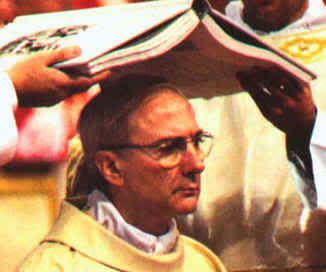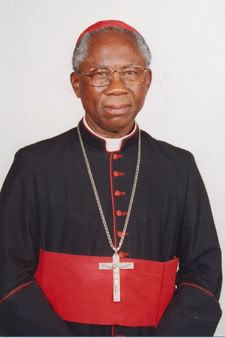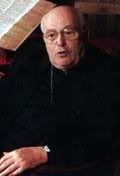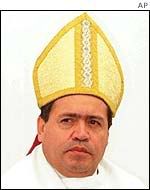No New Pope Today: Black Smoke Seen
Electing a new pope!

Roman Catholic cardinals from six continents locked themselves inside the
The 115 cardinals from 52 countries entered the chapel in a solemn procession that was broadcast live around the world.
They walked from the Hall of Blessings into the chapel as "The Litany of Saints" was sung. Once the cardinals were inside, the invocation of the Holy Spirit, "Veni, Creator Spiritus," was sung.
The cardinals -- clad in crimson robes, shoulder capes and hats -- each took an oath of secrecy, vowing not to disclose the discussions that take place in the conclave.
They will emerge from the conclave only when they have chosen the first new pontiff of the third Christian millennium and the 264th successor to St. Peter.
If the conclave resembles previous ones, the cardinals will need several days and repeated votes to reach a majority. (Selection process)
Earlier Monday, the cardinals held a special Mass in St. Peter's Basilica to pray for God's guidance.
The first clues to the process of finding a successor were sought during the homily or sermon delivered at the public
It was read by Cardinal Joseph Ratzinger of
"Having a clear faith, based on the creed of the church, is often labeled today as a fundamentalism," Ratzinger said during the homily.
"Whereas relativism, which is letting oneself be tossed and 'swept along by every wind of teaching,' looks like the only attitude acceptable to today's standards," he continued. "We are moving toward a dictatorship of relativism which does not recognize anything as for certain and which has as its highest goal one's own ego and one's own desires."
John Allen, CNN's Vatican analyst, said Ratzinger delivered a "very blunt" message for the church to "stay true to itself."
That was a strong indication that Ratzinger, 78, wants a "traditionalist" elected the next pope, Allen said.
After the Mass, the cardinals broke for lunch and rest. They began leaving the Hall of Blessings at 4:30 p.m. (1430 GMT/1030 EDT) and walked in a procession to the Sistine Chapel.
John Paul II put his own stamp on the centuries-old process before his death April 2 at age 84. John Paul appointed all but three of the 115 cardinals who will choose his successor.
Although a media blackout has been in place for more than a week, a number of cardinals have made it clear that there is no obvious heir apparent. (Potential successors)
"I think the race remains wide open," Allen said, calling this the first conclave in which Italians have not been in control in at least the early stages.
It's unlikely John Paul II made known any preference for a successor, said Chester Gillis, chairman of the department of theology at
"I just don't think it would have been in character for him to give the nod to someone," he said.
A Mass celebrated Saturday was the last held during the nine days of mourning that started with John Paul's funeral April 8. ( Full story)
The cardinals moved Sunday afternoon into the Domus Sanctae Marthae, on
The cardinals have been meeting since the pope's death, but the business of choosing a successor has not begun, Navarro-Valls said.
"No name was proposed, or spoken of, or even suggested," he said.
Once in the Sistine Chapel, each cardinal swore an oath, of which secrecy is just one part. The cardinals will swore to observe the changes to the process that John Paul put in place in 1996 and to faithfully carry out the duties of the office.
Quick vote?
Some
"If I were a betting man, which I'm not, I'm guessing by this April 21st, we'll have a new pope elected," the Rev. David O'Connell, president of the Catholic University of America, told CNN on Sunday.
John-Peter Pham, a former Vatican diplomat, noted that none of the past three papal elections took more than eight days and that some of John Paul's changes were intended to prevent an impasse. If no one has the required two-thirds majority after about 34 ballots, a simple majority will suffice.
"I couldn't anticipate a scenario where this would go much longer than a week," Pham said.
Ideally, a pope would be selected in three or four days, Allen said. Less than that could give the impression of a rush to judgment, and any longer could leave the impression the cardinals were divided, he said.
The longest interregnum occurred in the 13th century, lasting two years and nine months.
Choreographed voting
The balloting itself is elaborately choreographed. Each cardinal is given a piece of paper on which the words, in Latin, are inscribed: "I elect as supreme pontiff ... "
After noting their choices in handwriting they are are encouraged to disguise, each cardinal approaches a table in the Sistine Chapel in order of seniority, picks up a silver plate and places the ballot on top. He then puts the plate into an urn.
Three cardinals count each ballot, and another three check the counting to ensure its accuracy.
On Tuesday, a Mass will be held in the hotel at 7:30 a.m., and the cardinals will assemble in the chapel by 9 a.m. Two votes will take place in the morning and two more in the afternoon, beginning at 4 p.m.
After the votes, the ballots are burned in a stove, with the color of smoke from the chapel's chimney announcing to observers outside whether a pope has been elected.
In another change decreed by John Paul to avoid a repeat of the confusion that occurred at his election in 1978, when the smoke appeared gray, bells will also be rung to announce an election.
'Who can command respect?'
Should a voting bloc emerge, Italian cardinals could lead a push to return the papacy to an Italian, O'Connell said. John Paul was Polish -- and the first non-Italian pope in 455 years.
But O'Connell added that country of origin could prove less important than other factors.
John Paul was a youthful and vigorous 58 in 1978, when he was made pope, but "the feeling that is emerging" is that the cardinals might prefer someone "a bit more seasoned," O'Connell said.
Also high on the list of requirements for any candidate is likely to be an ability to speak multiple languages, travel and reach out to a global audience, O'Connell added.
The ability to respond to issues critical to the developing world could also prove key, O'Connell said. The number of Catholics and clergy is growing in Africa, South Asia and Latin America, even as their numbers have remained stagnant or dropped in Europe and the
"Their focus is going to be: Who can lead this global church in the 21st century? Who can command respect, provide the vision and the sense of hope?" he said.
Bookmakers have given high marks to Cardinal Ratzinger, Pham said.
But, he added, Ratzinger's role could prove to be less as candidate than as a "kingmaker," Pham said.
Cardinal Dionigi Tettamanzi, archbishop of
Allen said he felt comfortable excluding a number of candidates.
"I'm pretty sure the next pope is not going to be an American," he said. "The
St. Peter's Bells to Ring in New Pope!
Archbishop Piero Marini, Vatican master of liturgical ceremonies, has said that, in order to avoid any misunderstanding, the election of the new Pope will be heralded by the chiming of bells along with the traditional white smoke.

Archbishop Piero Marini
"The ritual of the stove should remain the same, but we will try and make it work better than last time. We will also ensure the bells chime, so journalists will be sure," he said in remarks broadcast on Vatican Radio.
During the two papal elections of 1978 - the last year any pope was elected - observers were baffled by the fact that the smoke coming out of the Sistine Chapel chimney often looked grey.
Black smoke indicates that no pope was elected.
As Joann mentioned in the last post in a comment, those will be very big shoes to fill. The process is as follows for selecting a new pope.
The College of Cardinals elects a new pope in conclave, which is the process of sequestering the voting members of the college in Vatican City so that they have no contact with the outside world. The word "conclave" comes from the Latin phrase cum clavis, meaning "with key." The term is suitable since the cardinals are locked inside the Sistine Chapel in the Apostolic Palace during the voting process.
A conclave begins no earlier than 15 days and no later than 20 days after the pope's death. Cardinals participating in conclave stay in St. Martha's House, a hospice inside the Vatican that has 130 rooms. Arrangements are made to ensure that the cardinals are not approached as they are transported between St. Martha's and the Sistine Chapel.
Pope John Paul II describes the complex procedures that will be used to elect the 265th successor to St. Peter in Universi Dominici Gregis (UDG), an Apostolic Constitution issued by the pope in 1996. It is an accepted practice for popes to publish the norms that regulate the election of their successors, and popes often make small adjustments to the procedures. According to John Paul II, these changes are made "with the intention of responding to the needs of the particular historical moment."
According to the UDG, here are the current rules for electing a new pope:
- The maximum number of electors from the College of Cardinals is 120. The college is currently composed of 194 cardinals.
- Any cardinal who turns 80 before the day the Papacy is vacated, either by death or resignation, cannot take part in the election. Currently, 135 cardinals are eligible to vote under this rule (15 of those 135 would be disqualified from the vote because the limit is 120).
- A two-thirds-plus-one majority is required to elect a pope.
- Two ballots each are held in the morning and afternoon, for a total of four per day.
- If a new pope is not selected after 12 to 13 days, the cardinals may choose to impose a majority vote, which would allow selection of a new pope by a simple majority.
Each rectangular ballot is inscribed at the top with the words Eligo in Summum Pontificem, meaning "I elect as supreme pontiff." Below these words, each cardinal writes down the name of the person he chooses as the pope. The vote is done in secret with paper and pen. The voting cardinal then folds the ballot twice, holds it in the air, and carries it the chapel's altar. He then says, "I call as my witness Christ the Lord who will be my judge, that my vote is given to the one who before God I think should be elected." The cardinal places the ballot on a plate that sits atop the ballot receptacle and uses the plate to drop the ballot into the receptacle. After bowing before the altar, he returns to his seat.
Three Scrutineers, who are selected by all of the cardinals, are charged with counting the ballots. Once the ballots are collected, the Scrutineers count the ballots to determine if everyone has voted. If the number of ballots doesn't match the number of electors, the ballots are immediately burned and another vote is taken.
Here are the steps for the vote-tallying procedure:
After each vote, the ballots and any notes regarding them are burned. Smoke from the burning of the ballots appears over the Vatican Palace. If no pope has been chosen, a chemical is applied to the ballots in order to create black smoke when burned. White smoke signals that a pope has been elected.
- The first Scrutineer takes a ballot, notes the name on it, and passes it to the next Scrutineer.
- The second Scrutineer notes the name and passes it to the third Scrutineer.
- The third Scrutineer reads aloud the name on the ballot, pierces the ballot with a needle through the word Eligo at the top of the ballot, and slides the ballot onto a string of thread.
- Each elector notes the name that is read.
- Once all ballots are read, the Scrutineers write down the official count on a separate sheet of paper.
- The third Scrutineer ties the ends of the thread on which the ballots are placed in a knot to preserve the vote.
- The ballots are placed in a receptacle.
The newly elected pope remains pope for the term of his life, or until he retires. His reign is referred to as a pontificate.
How a Pope Is Elected
For 900 years, electing a pope has been the prerogative of the College of Cardinals meeting in conclave. The cardinals meet in Rome 15 to 20 days after the death of a pope and pick a successor from among themselves in secret balloting. Pope John Paul II wrote the rules for electing his successor.

Papal Candidates
I know there are many more than what I have mentioned here to be considered. Cardinals are streaming toward the Vatican to elect a new pope. Here are just a few of the top candidates that stand out in my mind:

There hasn't been a black pope for 1,500 years - but one man from Nigeria has emerged as a leading contender to replace John Paul II as the next head of the Catholic Church. Jane Little assesses the rise and rise of Cardinal Francis Arinze.
In March of this year, Pope John Paul II paid his second visit to Nigeria. There ostensibly to beatify a priest, the aging pontiff attracted huge, enthusiastic crowds, eager to hear his message on human rights and religious freedom - commodities in short supply in Africa's largest Catholic country. But one of the loudest cheers went up when the pope proclaimed, during a mass, "Cardinal Arinze is very proud of you."
Nigerians are clearly very proud of him too. To many of the twelve million Roman Catholics in the country, he represents the rising fortunes of African Christianity from its humble origins little more than a century ago, to the corridors of power in Rome. What's more is that he's not only there by the Pope's side; he's being tipped by many as well-placed to assume the reins after John Paul's day. Newspapers in Lagos have already headlined: 'Nigerian next Pope.'
Full Story HERE

Godfried Danneels
Belgium

Norberto Rivera Carrera
Archbishop of Mexico City

Christoph Schönborn
Archbishop of Vienna

Cláudio Hummes
Brazil
How a pope is elected
Papal Names
The Vatican Homepage
Online virtual tours of the Vatican Museums
Biography of John Paul II
Sacrament of Penance
Vatican warns about dangers of on line confessions
About Catholic Excorcism
Marian Prayer of John Paul II
What I do is kick them in the pants with a diamond buckled shoe!
~~Aileen Mehle~~







0 Broken Heels:
Post a Comment